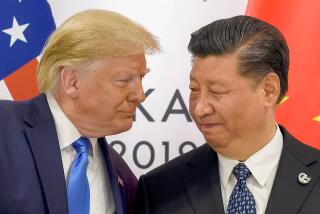Trade Gap Falls to $10.7 Billion for December
WASHINGTON — The U.S. trade deficit grew by a relatively modest $10.7 billion in December, according to a Commerce Department preliminary report Friday, but the estimated trade gap for all of last year still was a record $169.8 billion.
The unexpectedly sharp drop from the $19.2-billion preliminary deficit figure for the previous month helped push the dollar up strongly in currency trading, easing fears of a drastic decline in its value.
And the figures, indicating the narrowest monthly gap between imports and exports since March, 1985, suggested to analysts a possible boost for the economy, which has been hurt by the ballooning trade deficit.
However, economists warned against expecting the politically sensitive trade figures to show any dramatic turnaround in 1987.
Correction Under Way
The report, which also significantly lowered the original estimate of November’s trade gap, “clearly shows that a correction in the nation’s trade imbalance has been under way for several months,” said Howard Rosen, a research associate at the Institute for International Economics here.
“But this latest monthly figure probably exaggerates the gains, and no doubt it will be quite a while before the numbers really start looking good enough to help defuse protectionist sentiment in Congress,” he said.
The improved December trade figures indicate that the two-year-long fall in the dollar’s value finally has halted the deterioration of the American trade position.
As the value of the dollar has fallen against several other major currencies, it has aided U.S. manufacturers by making their goods less expensive in world markets and by forcing foreign exporters grudgingly to increase their prices to halt the dramatic erosion in their profits from American sales.
At the same time, the dollar’s decline has had an initially perverse effect on the trade deficit figures, because the more expensive imports become the more the overall value of imports swells, adding to the trade deficit. As a result, overall import figures have been little changed, even though the volume of imports finally began to shrink in recent months.
The Reagan Administration hailed December’s sharp improvement but cautioned against putting too much credence in one month’s report.
Deficit ‘Leveling Off’
Treasury Secretary James A. Baker III told reporters: “I don’t think you can conclude from this that the trade deficit is declining. You may be able to conclude that it is leveling off. One month is not all that good an indicator of a trend.”
The December figures did support Administration officials’ contention that the alarming $19.2-billion deficit cited in the preliminary report for November was a fluke.
The new report significantly lowered the earlier November estimate to $15.4 billion, which was far less out of line with the average $14.9-billion trade gap of the previous four months. The revised figure for December will not be available until near the end of next month.
The Commerce Department, in response to growing concerns about the unreliability of its initial estimates, has decided that, starting later this year, it will delay its trade report for 10 days to allow time for more accurate calculations.
Warning on Oil Prices
For this year, economists warned that a rise in oil prices will exacerbate the trade deficit. If oil prices remain steady at today’s level, about $4 a barrel higher than last year’s average oil price, it would roughly translate into a $10-billion hike in the nation’s annual cost for imported oil.
“If the rest of the trade balance improved by $10 billion, we would have no change at all because of the rise in oil prices,” said Michael Evans, president of the Evans Economics consulting firm here.
However, even without a dramatic narrowing of the overall trade deficit this year, the nation’s hard-hit manufacturers finally appear to be gaining ground against their foreign competitors.
“The December improvement reflected primarily a lower deficit for manufactured goods,” Commerce Secretary Malcolm Baldrige said in a statement.
Farm Products Gain
According to the preliminary report, the deficit in manufactured goods in December fell to $9.8 billion from $16.8 billion in November. Farm commodities also showed a sharp gain, with the trade surplus in agriculture rising for the fifth month in a row to $781 million.
The nation’s trade gap has narrowed for four of the last five months.
But, for the full year, the $169.8-billion estimate for the trade deficit marked a deterioration of $21.3 billion from 1985 and was more than $127 billion larger than in 1982.
Manufacturers Hurt
Manufacturers bore the brunt of the overall trade deficit last year, with imports of $293.8 billion nearly double exports of $148.7 billion.
Oil imports added about $24 billion to the trade deficit last year. But, because prices fell sharply, the cost of imported oil was significantly lower than in previous years. Agricultural commodities registered only a $2.9-billion surplus, down from $7.2 billion in 1985 and a dramatic fall-off from the $19.6-billion farm surplus in 1982.
More to Read
Inside the business of entertainment
The Wide Shot brings you news, analysis and insights on everything from streaming wars to production — and what it all means for the future.
You may occasionally receive promotional content from the Los Angeles Times.










